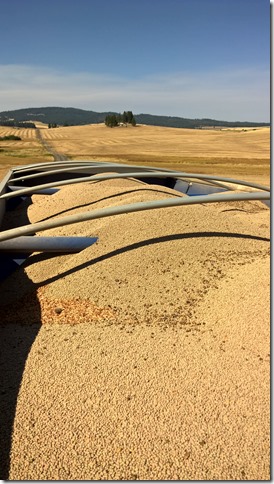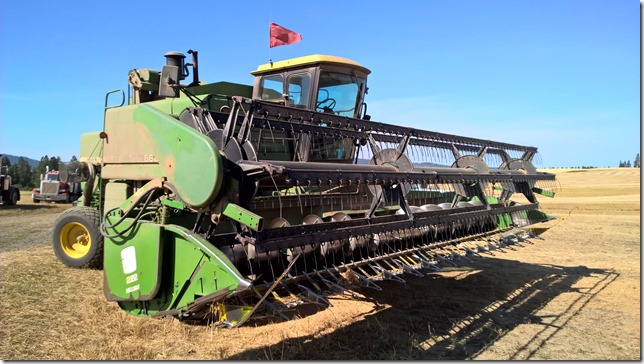While I was in Idaho weekend before last I helped my brothers just a little bit with the harvest. They were working on the lentils and I took a few pictures:
Want some lentils? How many tons would you like? There are probably about 15 tons in this picture.
This is one of the two nearly identical machines they use to harvest the crops on our land.



Lentil soup is badass.
How much ham and how many onions to go with 15 tons of lentils? Now I’m hungry…
I’m thinking approximately 6 to 7 tons of ham and about the same of onions, and a few of those 40 pound bags of salt. Season to taste. You’re on your own as far as setting up the stove and cooking pot though, and taking care of any leftovers. Someone at Campbell’s Soup could talk these numbers all day, I reckon.
Hmmm… you must be thinking of soup. I’ve never made lentil soup so I wouldn’t know without looking it up. I make cookies and pizza with them. But more frequently I make what my kids “lovingly” call “Lentil Crap”.
Lentil Crap would require about 1.8 x the volume of lentils in water, and about four slices of cheese per half cup of dry lentils, and garlic salt seasoned to taste. Simmer the lentils for 20 to 30 minutes (until tender) in the water, stir in the garlic salt, put the slices of cheese on top, cover and wait about five minutes for the cheese to melt. Mix in some crisp bacon or cooked ham at the same time as the garlic salt for more protein and some variety.
To a midwestern farm hand, that lentil head sure looks weird compared to a corn or bean or wheat head.
It’s not really a “head” like with wheat, corn, or barley. I’m not really familiar with soybeans so I can’t compare them to those.
It is very similar to a pea plant with pods scattered most of the length of the vine. The main difference from peas is that the vines are much shorter, stand upright even when ripe, and the pods typically only have two seeds in them.
A bean head is very similar, with the reel, but this front looks like a two-tiered bean head. A bean head has a continuous sickle bar on the bottom edge, the reel, and an auger in the back. The soy bean plant grows to about 3 feet tall, and has pods almost the whole length. Three to five beans to a pod. Interesting to see how equipment is built to do a specific job…..
Oh! Your definition of “head” is what we call the “header” of the combine. I thought you were talking about the head of the plant as in a head of corn, wheat, or barley.
The sickle you see in this picture is on what we call “the pea bar”. Some peas vines may grow to be five or six feet tall but fall to the ground by the time they are ripe. At the time of harvest they form a matt about eight to 12 inches thick on the ground. The pea bar was invented in our area by someone 60 years ago or so to “float” on the ground and lift the vines up into the header and then cut the vines off close to the ground.
We have a more conventional header we put on for the wheat, barley, canola, and other crops which are tall enough they can be cut at least a few inches above the ground. On our combines 10 years or more ago we would swap the pea bar and the normal sickle on the one header we had for the combine. But they managed to find extra headers fairly cheap and just leave the pea bar on one header and have the conventional sickle on the other. You can change headers in an hour or so but changing between pea bar and sickle was about a half day task. Time is sometimes very important during harvest and having the extra headers was worth it.
Sometimes the lentils get tall enough that they will use a conventional sickle with them. Other times they are so short you have to use the pea bar. This year they were on the short side so they used the pea bar.
The equipment evolves differently, and so does the language! (And most farmers around these parts have two headers: a corn header and and bean header, which is easily converted to use for oats, barley, or winter wheat. For the same reasons you describe.)
I love me some lentils, but I don’t think I have a pot big enough.
The next time you are in the Seattle area let me know and I’ll fill up the empty spaces in your suitcase with lentils for you at less than half the price you could buy them in the store.
Deal!
Why is there a flag on the harvester’s cab?
Good question! I asked the same question when I first saw the flags a few years ago.
The combines (harvester in your words) are nearly identical and one has a red flag and the other a blue to help distinguish them. The most useful time for this distinction is when one combine radios for the truck driver because the combine needs to be unloaded. Example: “Bring the truck to the blue combine so I can unload.” Also for maintenance issues as in, “The straw chopper belt on the red combine is getting loose.”
It’s difficult to see with all the dust covering them but the spout on the unloading auger is also painted the same color as the flag.